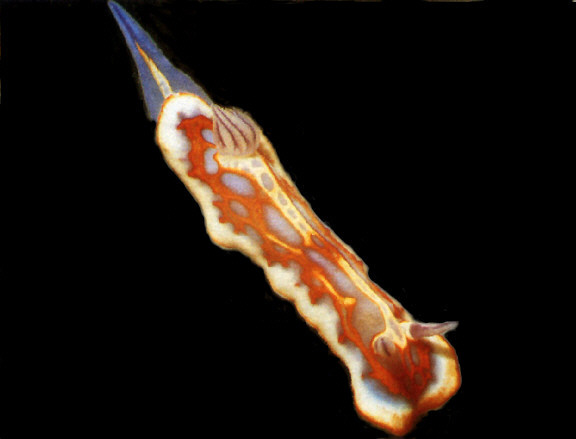
Chromodoris britoi?
Chromodoris britoi Ortea & Perez, 1983
According to Cattaneo Vietti, C. Britoi is a rare Atlantic-Mediterranean species, the few known specimens come from the Canary Islands, Gulf of Naples, Sicily. My collections of C. brito has been along the Ashqelon coast of Israel during the months June to September repeatedly since 1982. The smallest individuals appear at late june and are a few millimeters in length and may reach 2.5 cm in length in late August or September. None were found during any other months and I wonder whether it is connected with the fact that these are are the warmest months (water temperature reaches 84 degrees in August and September). C. britoi can be found in crevices at 10-15 m depth. There are not too many rocks in the Ashqelon area and it is not such an easy task to find them. one has to swim/use a boat to get to about 1.5 km off shore where the depth is 12 m (~30 feet). Therefore all my observations are from a single rock formation which was repeatedly visited over almost ten years. C. britoi has been found in the vicinity of a of a suspected food source, a black sponge, but this has not been confirmed. The egg mass is white creamish and has a ribbon shape.
To make the whole situation even more complicated, It should be noted that a few kilometers south of Ashqelon (almost on the gaza strip border), there is an oil port. It is located at the northern end of a pipe line that connects Eilat (at the tip of the gulf of Aquaba) and Ashqelon. Oil tankers from all over the world come here every few weeks. Some of these even come from as far as Venezuela so who knows what they carry with them.
More than ten years ago this photograph was sent along with a few others to La Conchiglia as Chromodoris clenchi which was the identification suggested by H.K. Mienis. The editor (of course) made a mistake and named it Hypselodoris gracilis which is obviously wrong and created a floury of correction messages which where published in a later issue. Here are some of the responses:
>From H.K. Mienis curator of the mollusc collection at the Hebrew University in Jerusalem:
"... A study of their beautifully executed coloured figure and their text, convinced me that Gat's specimen from Ashqelon were not conspecific with H. villafranca nor with any of the other species from the Mediterranean or the Red Sea ( as far as the latter are known to science). As a matter of fact they showed much more affinities with a western atlantic species described and figured as Chromodoris clenchi (Russell, 1935) =Chromodoris neona (Marcus,1955) by Thompson (1977,1980). This species was so far known from Bermuda Florida, Jamaica,Columbia, Panama and Brazil..."
>From Dr. Philippe Bouchet of the Laboratoire de Biologie des Invertebres marins et Malacologie del Museum Naturelle of Paris:
"... this is not Hypselodoris gracilis but Chromodoris neona , Marcus. but there is still another possibility, that it is another species recently described for the Canary Islands and named Chromodoris britoi Ortea & Perez..."
>From Dr. Ortea (institute of Zoology of the university of Oviedo, Spain)
"... I think that the the nudibranch illustrated as H. Gracilis on page 17 of no. 4/83 could be an old specimen of what we have recently described for the canaries as Chromodoris britoi Ortea & Perez 1983 a species which lives also along the Mediterranean Spanish coast as we were able to ascertain recently..."
>From Dr. Terry Gosliner, California Academy of Sciences
"...The Ashqelon specimen pictured above collected from the Mediterranean coast of Israel is probably Chromodoris britoi Ortea & Perez, 1983. Ortea, Valdes & Espinosa have recently reviewed the Chromodoris clenchi species complex and consider there to be four distinct species based on small color and anatomical differences. Provisionally, they place the Israeli specimens in C. britoi. More detailed investigations is required to further differentiate members of this species complex....".
Dr. Russell H Jensen , assistant curator of the mollusc department of the Delaware Museum of Natural History, in a letter mentioned the same suspicion that Gat's specimens of H.Gracilis might be identical with Chromodoris clenchi. Dr. Jensen enclosed two photographs of a western atlantic specimen and from those it is clear that the Ashqelon specimens are indeed very similar to if not identical with Chromodoris clenchi.
As the reader ponders this issue, consider two images generously provided by Jeff Hamann of El Cajon, California. The images are Chromodoris clenchi (Russell, 1935) taken in the western Atlantic (Caribbean) region! Examination of these images would on appearance seem to support H. Meinis's opinion that the Ashqelon specimen is C. clenchi!
Photo and Text courtesy of:
Dr. Gil Gat
Send Dr. Gat E-Mail at phldiana@netvision.net.ilFor those of you interested in the photographic background information of the images, the following may be of interest!
Camera System: Nikon FM2
Location: Ashqelon coast, Israel
Scanner: Microtek IIsp color scanner
Photo Editing: PhotoStyler 2.0 on 486 DX-2 33 mhz/ 64 megs RAM
© The Slug Site, Michael D. Miller 1995, 1996. All Rights Reserved.
